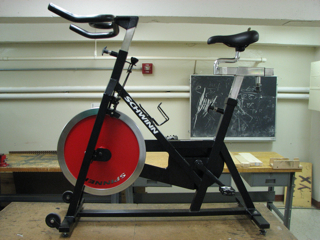Exercise bike
From DDL Wiki
Contents |
Executive Summary
Product Function
Product Use
The product is a stable platform used for cycling practice as well as a smooth, intense workout. The user mounts the bike, sitting on the seat. Feet rest on the pedals and hands on the rubber handles to the front of the bike. While holding the handles, feet on the pedals and sitting on the seat, the rider is provided a stable riding position. To ride, the user pedals forward (backward is not recommended by Schwinn) exerting significant effort to build momentum in the heavy flywheel. Once user reaches a comfortable speed their effort levels to a steady pace. There are a few ways to stop, all not very intuitive to basic bike riders. There is a knob on the frame that can be turned to apply a clamp-brake to the flywheel that will slow the wheel down. The user can also completely remove their legs from the pedal assembly, but this is not recommended since it is dangerous and the momentum in the wheel is too high and will spin for a very long time. The user could also cool down by gradually reducing their pedal speed till it becomes slow enough to dismount. This is recommended anyway in any strenuous workout, stopping abruptly is not good for the body.
Bill of Materials
| Part/Sub-assembly | Part # | Part Name | QTY | Weight (g) | Function | Manufacturing Process | Material | Image |
|---|---|---|---|---|---|---|---|---|
| Seat | 1 | Seat | 1 | 428 | Allows user to sit on bike | press fit/lay over cloth and stitch | foam, plastic, stainless steel | |
| - | 2 | bolt | 1 | 25 | Assembles seat to seat support | forging, thread rolling | stainless steel | |
| - | 3 | sm. washers | 2 | 15 | Assembles seat to seat support | stamping | stainless steel | |
| - | 4 | lg. washers | 2 | 15 | Assembles seat to seat support | forging, thread rolling | stainless steel | |
| - | 5 | nuts | 2 | 5 | Assembles seat to seat support | casting thread tapping | stainless steel | |
| - | 6 | solid support | 1 | 1725 | Connects seat assembly to seat attachment | casting thread tapping | stainless steel | |
| - | 7 | nuts | 2 | 5 | Assembles seat to seat support | casting thread tapping | stainless steel |
All extra weight on frame =
10271
- We were not able to dissect the wheel sub-assembly due to the high pressure that the assembly is under at all times. Dissecting the wheel would be extremly dangerous, and once it was dissected, getting the wheel under the same high pressure would have requried special tools that we do not have access to. The conclusion that dissection was not a good idea was supported by the expert machinists in the Carnegie Mellon machine shop in Hamerschlag Hall.
- Removing the bike pedals from the bike frame was not a possibility for our group due to the need of a special bike-specific tool called a crank arm extractor. More information can be found by watching this video: http://www.youtube.com/watch?v=H6aHvq4oD9o. In addition, the sprocket is welded to the pedal crank, making it impossible to remove.
Design for Manufacture and Assembly (DFMA)
Design for Manufacture
Design for Manufacturing
This product is heavy and rugged. Looking at all of the components, several design choices were made for manufacturability of Spinners in batch quantities. The frame consists largely of steel square tubing and is cut at different angles to be welded together. Therefore the frame is very rigid, since almost all joints are welded instead of fastened. The main goal of the frame is to be stable. Therefore the design strategy we see that considered manufacturability is:
-Keep the frame simple and cost effective
-Used inexpensive and simple tubing
-Cut pieces at angles to be welded, no bending
-Use heavy material to add to stability of frame
-Steel tubing
The handle and seat assembly have curved steel pieces. Mounting to the frame could have been complicated but instead were designed very simply, not only for assembly but for the sake of manufacturing separate parts at a lower cost. This way only a small piece of material had to be bent in part 7. The handles (part 9) have a large amount of bending required, but this may be due to the requirement of good ergonomics and worth the additional manufacturing cost.
-Complicated parts were made simple by using multiple parts
-These parts assemble easily (pull pins)
-Requires less machinery in-house, more importing of material/components
Along a similar line, many of the other components were bought off the shelf because manufacturing them in-house would be very costly and inefficient. Things like bolts, nuts, washers, and springs would most likely have been purchased from a supplier whose expertise is mass producing such components. This greatly saves costs as long as Spinners are made in batch sizes. If these bikes were in large-scale mass production then some of these common parts would be made in house, but Spinners are special items and not produced in large enough quantities to warrant mass production manufacturing techniques.
Design for Assembly
Casey
FMEA
Boss
Design for Environment (DFE)
Abe and Casey
Mechanical Analysis
Shobhit

